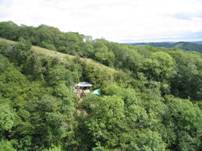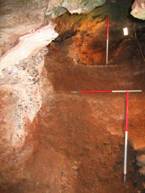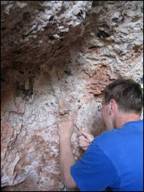
Harrow and Hillingdon Geological Society
Wolves and Wildcats
Home | Monthly Meetings | Field Trips | Exhibitions | Other Activities | Members Pages | Useful Links
Wolves and wildcats: surviving the end of the last ice age in Somerset
Professor Danielle Schreve
This presentation covered ongoing research in Somerset, which gives an insight into biological responses to very abrupt climate change.
Gully Cave, Ebbor Gorge, Somerset
The Ebbor Gorge National Nature Reserve is on the south-west flank of the Mendip Hills just north of Wells. It is a steep-sided ravine cut into the Carboniferous Clifton down Limestone. Small caves with mostly late prehistoric occupation were already known in the gorge. The gorge is owned by the National Trust and managed by Natural England.
The object of current investigations is a small cave, Gully Cave, high up in the gorge near the top of a gully running down from the Mendip plateau. It was found as a result of the blowing down and uprooting of an ash tree in front of the cave. A 50cm-high slot was exposed and excavation has enlarged the entrance, which tapers downslope along the gully. Initially there was an agreement with the National Trust to leave 50% of the cave undug but this has now been relaxed.
|
|
|
Gully Cave study site from across bbor Gorge |
Gully Cave as first discovered |
Gully Cave entrance after excavation |
Initial excavation exposed the very top of the limestone breccia in the cave and a single vole tooth was found. The research team have gone back every year since and now have 5m of deposits exposed. There is a very thin horizon of modern soil at the top and immediately below this was a stalagmite floor, which capped the deposits below. The deposits are pristine Pleistocene deposits in situ. Uranium-series dating will be used in due course to date the stalagmite floor. The cave has 3-4m of red limestone breccia, which is notably coarser towards the base (possibly due to collapse of the roof). Towards the side of the cave the deposits become white due to carbonate rich waters cementing the sediment in situ. This is probably the largest of the caves in the Ebbor Gorge but the team has not yet found the floor.
Small mammals
There is an extraordinary abundance of microfauna representing a mixture of open environments, open aquatic and shrubby areas. The preservation is superb, with teeth still in the jaws. A lot are still living in Britain today, such as the short-tailed field vole, water vole, wood mouse, pigmy shrew, water shrew and bank vole, but others, such as the narrow-skulled vole, root vole, Norway lemming and collared lemming, are not found in Britain today and are essentially Arctic, Scandinavian of central Asian species. There is very abundant mountain hare, a species which today is restricted to Scotland and Ireland.
|
|
|
|
Excavatons in Gully cave |
Right jaw of water vole |
Articulating horse limb cemented to cave wall |
Discolouration on bone |
Large mammals
Heavily cemented against the north and east walls of the cave are articulating fore and partial hind limb of wild horse. Red deer are less common but reindeer are more common, both adult and juvenile, including many broken long bones. There are articulating hind limbs of aurochs, indicating the presence of complete haunches of the meaty parts of the body. Carnivores are well represented, with wildcat, weasel, polecat and arctic fox and some of the bones show evidence of gnawing by a large carnivore (wolf?).
Birds
There is a range of medium-sized ducks, a small falcon (kestrel-sized), including juveniles, long-eared owls, grey partridge, passerines including thrushes, finches, and a jackdaw with amedullary bone, which is laid down in the egg-laying season.
Survey
The cave is being surveyed using 3-dimensional laser survey by colleagues from the University of Southampton. The aim is to explore the data in 3 dimensions by creating a shell of the cave with the data points plotted inside.
Taphonomy
How did the material get into the cave? The sediment entered the cave via the gully and through pipes in the cave ceiling. There is evidence of gnawing on horse and red deer bones. Clear evidence of differential digestion and breakage on small mammal bones indicate raptor accumulations, ie fossil pellets ejected by eagle owl and other species (?). There is no evidence of weathering of bones. Different birds of prey were involved. For example barn owls modify remains very slightly, tawny owl pellets show moderate modification and the most modified are mammalian predators.
Human activity
No stone tools have been found so far but there are indications in the presence of articulated limbs of large mammals and a cluster of bones at the back of the cave with green-bone fractres consistent with the extraction of bone marrow. There is discoloration on the bones of deer, horse, hare and birds but no sedimentological or chemical reason for the staining. It is more consistent with the bones having been not burnt but near a source of heat. There is also a suggestion of charcoal in the deposits. The team intend to carry out experiments burning material and burying it at different depths to see whether this replicates the staining.
Palaeoenvironment and age
The sediments were deposited in a cool climate and steppe/tundra conditions but there was also a mix of temperate elements. Open ground conditions above the cave are indicated by the presence of Pupilla muscora, horse and microtine rodents and scree slopes by Vitrina pelucida. More sheltered areas included trees and shrubs in the gorge. A local water source is indicated by Golba truncate. Overall the sediments represent considerable climatic complexity.
Molluscs from early late glacial times are joined by post-glacial species. 20,000 years ago was the last glacial maximum, followed by a brief period of elevated warmth with very rapid warming of 6 or 7 o in a period of decades to 100 years. This was followed by a period of cold then rapid warming to the present day. The interglacial megafuna in Britain dwindled early, with lion and rhinoceros disappearing 29,000 years ago, though mammoths lasted a little longer.
Radiocarbon dates on the Gully cave material show that the earliest fossils are consistent with the period of rapid warming just after the last glacial maximum. Horses disappear with the spread of birch woodland and red deer replace them. The fossils represent a beautiful complete group including the younger Dryas assembly. This is a unique record for Britain in its completeness.
Correlation with other sites
Gough’s Cave in Cheddar Gorge, in which human remains were found, has been dated at 12,600±80 to 12,415±60 BP, which correlates with the oldest Gully Cave material. It has indications of selective predation on horse (90% of the fauna), red deer, mountain hare & lynx. Bones show similar staining and there are human tools, cut marks on bones and evidence of cannibalism in the cut-marked and butchered human remains.
Together with other sites, these indicate that occupation of south-west England by humans was consistent with the period of rapid warming. Sites around Cresswell Crags in Derbyshire were occupied slightly later and there is a transition from horse to mountain hare.
As already indicated, the faunas are a mixture of those still present in Britain and arctic or central Asian species. The question arises as to whether this reflects the presence of non-analogue disharmonious faunas or is due to a lack of resolution. Gully cave has, in fact, very high resolution and the evidence to date may support the theory of cryptic northern refugia, ie not everything retreated as the climate cooled but some continued in refugia in sheltered areas such as Ebbor Gorge. Sun Hole and Soldier’s Hole, also in the Mendips represent the same period as Gough’s Cave and have saiga antelopes.
Summary and future work
Gully Cave has a high-resolution palaeoenvironmental record through the late glacial period underpinned by a robust chronology.
It is intended to –
- extend the excavation southwards to an undug block and deeper to explore the potential for evidence of human activity;
- analyse the spatial distribution of finds and taphonomy;
- examine evidence that the timing of the return of Homo sapiens to Britain was coincident with the period of rapid warning just after the last glacial maximum, the Glacial Interstadial 1e; and
- further investigate the nature of environmental change over the Late Glacial period






